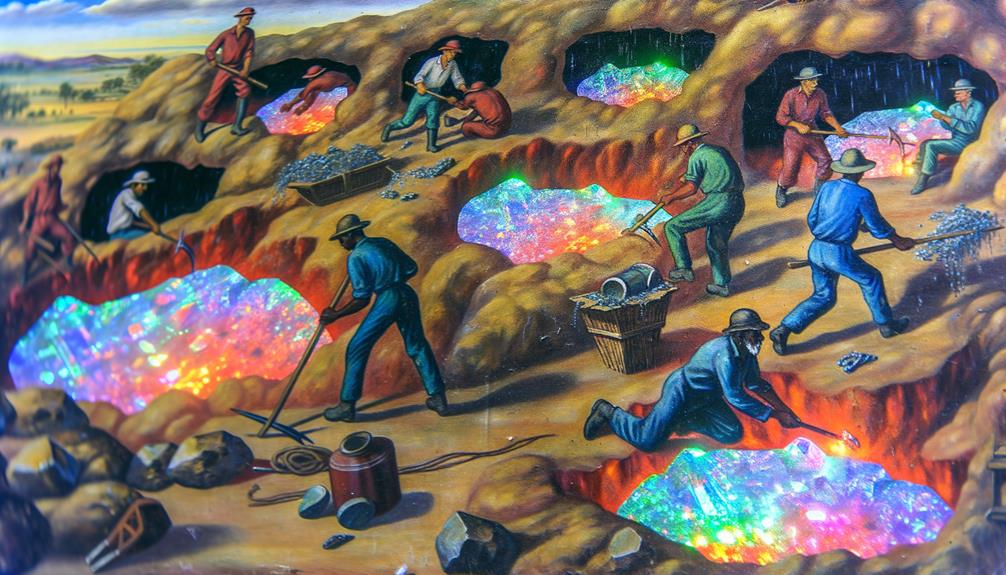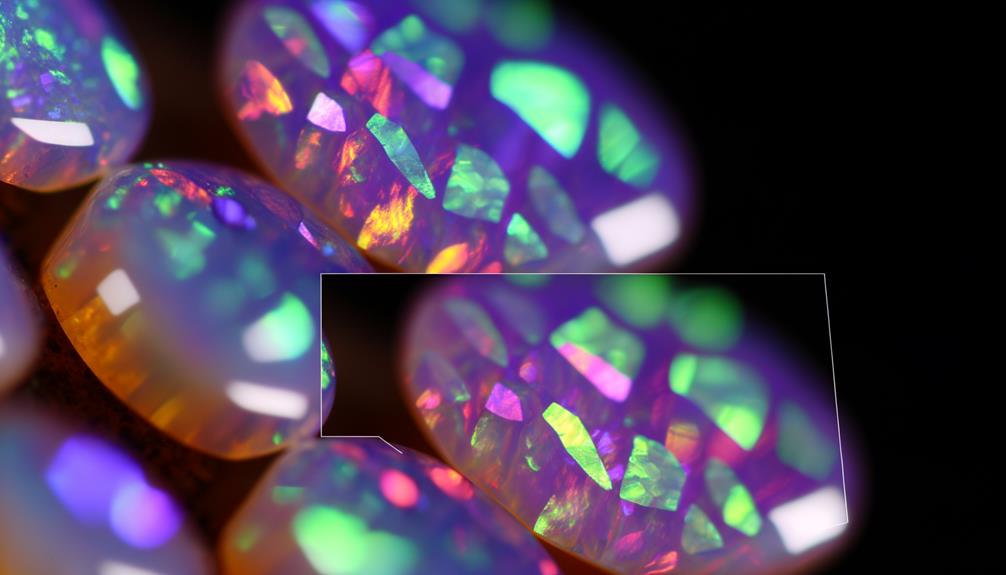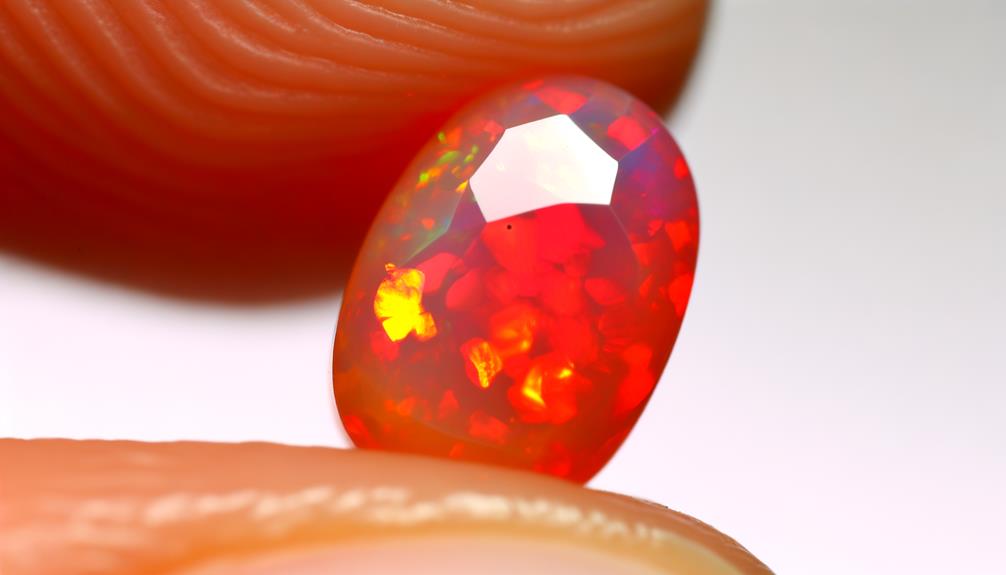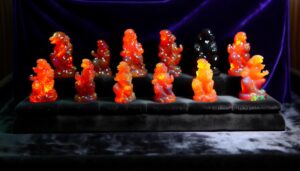How Are Fire Opals Natural or Man-Made?
Yes, fire opals can be man-made. Synthetic fire opals are engineered to imitate the vivid hues and play-of-color of natural opals.
They exhibit remarkable uniformity in color and clarity, often featuring fewer inclusions and a more organized structure. Natural fire opals form through silica-rich water percolating volcanic rock, which then hardens under heat and pressure.
While synthetic variants offer visual appeal and consistency, natural fire opals hold unique traits and a higher market value. You can explore more about evaluating these enchanting gems and their uses in sophisticated jewelry to make an informed choice.

Key Takeaways
- Fire opals can be both natural and synthetic.
- Natural fire opals form through geological processes involving silica-rich water and volcanic rock.
- Synthetic fire opals are engineered to mimic the appearance and properties of natural fire opals.
- Synthetic fire opals offer enhanced clarity and uniform play-of-color compared to natural ones.
- Natural fire opals, especially from Mexico, are highly valued and more expensive.
Understanding Fire Opals

Fire opals, renowned for their vibrant play of colors and unique iridescence, are a type of opal that captivates with their fiery hues ranging from yellow to deep red.
You'll find these gems exhibit a unique spectral phenomenon called 'play-of-color,' where light diffracts within the silica spheres, creating a mesmerizing display.
Fire opals, unlike common opals, often lack a prominent internal structure, which results in their transparent to translucent appearance. The presence of iron oxide gives them their characteristic warm tones.
When evaluating fire opals, you should consider factors such as clarity, color saturation, and cut. High-quality specimens are known for their vivid, uniform coloration and minimal inclusions, making them highly prized in the gemological world.
Formation in Nature
The formation of fire opals in nature involves the intricate process of silica-rich water percolating through volcanic rock. Eventually, it deposits silica gel in cavities and fissures. Over time, a unique interplay of heat and pressure causes this gel to harden, leading to the creation of fire opals.
This geological phenomenon requires precise conditions: the right temperature, pH, and mineral content. The vibrant play-of-color that characterizes fire opals results from the diffraction of light through submicroscopic silica spheres. These spheres form a regular, grid-like pattern, which breaks light into spectral colors.
Understanding these processes helps you appreciate the natural artistry involved in the formation of these enchanting gemstones.
Mining Locations

While the complex natural processes shape fire opals, their extraction primarily occurs in specific geological regions known for their unique volcanic activity.
You'll find the most renowned fire opal mining locations in Mexico, particularly in the states of Querétaro and Jalisco. These regions boast extensive volcanic deposits, providing the ideal conditions for opal formation.
Additionally, Nevada in the United States hosts significant fire opal mines, especially in the Virgin Valley. Here, hydrothermal processes within the volcanic tuff layers contribute to the creation of these vibrant gemstones.
Australia, another notable source, has fire opal deposits in the Lightning Ridge area. Each of these locations offers unique geological conditions that foster the development of high-quality fire opals, making them prized mining sites.
Characteristics of Natural Fire Opals
Natural fire opals exhibit a mesmerizing play of color, known as opalescence, resulting from their unique internal structure and silica content. You'll find that these gems display vivid hues ranging from fiery reds to warm oranges and yellows. Their transparency varies, often showing an enchanting, glass-like clarity. The internal structure, composed of silica spheres, diffracts light to create their signature play-of-color.
Key attributes include:
- Color Range: Spanning from red to yellow, with occasional green flashes.
- Transparency: Ranges from transparent to translucent, enhancing visual depth.
- Hardness: Rates 5.5 to 6.5 on the Mohs scale, indicating moderate durability.
Understanding these characteristics helps you appreciate the natural beauty and complexity of fire opals, setting them apart from their synthetic counterparts.
Synthetic Fire Opals

Compared to their natural counterparts, synthetic fire opals are engineered to mimic the vibrant colors and opalescence using advanced laboratory techniques. You'll find that these lab-created gems exhibit unparalleled uniformity in their play-of-color, thanks to precise control over their internal structure.
Technicians replicate the silica sphere arrangement, ensuring the characteristic diffraction of light that natural opals possess. This meticulous engineering results in synthetic fire opals that can sometimes surpass natural ones in visual appeal and durability. Additionally, these synthetics often contain fewer impurities, enhancing their clarity and color vibrancy.
While synthetic fire opals are chemically identical to natural ones, their creation in a controlled environment allows for consistent quality, making them an attractive option for both collectors and jewelers.
Creation Process
To create synthetic fire opals, technicians meticulously layer silica spheres in a controlled environment to replicate the natural formation process.
This highly regulated procedure involves several critical steps:
- Uniform Layering: Technicians confirm that the silica spheres are evenly layered, mimicking the structure found in natural opals.
- Controlled Environment: Temperature and humidity are precisely controlled to facilitate the proper formation of the opal's internal structure.
- Aging Process: The layered spheres undergo a maturation phase where they bond and develop the characteristic play-of-color seen in fire opals.
Identifying Synthetic Opals

Recognizing synthetic fire opals involves examining their unique structural characteristics and optical properties, which can subtly differ from their natural counterparts. You should inspect the opal's internal structure under magnification.
Synthetic opals often exhibit a more uniform and regular pattern known as 'columnar structure', unlike the random arrangement in natural opals. Pay attention to the play-of-color; synthetic opals might display an overly vivid and organized color play due to their controlled formation process.
Additionally, check for inclusions. Natural opals typically contain organic inclusions, while synthetic ones might show microscopic bubbles or lack inclusions entirely. By focusing on these structural and optical indicators, you can more accurately determine the authenticity of the fire opal in question.
Visual Differences
When discerning between natural and synthetic fire opals, you'll notice several visual differences that can serve as key indicators of authenticity. Natural fire opals typically exhibit irregular patterns and a varied play of color, whereas synthetic ones often display a more uniform and consistent appearance.
Additionally, the body color of synthetic fire opals can appear overly vivid and less nuanced compared to their natural counterparts.
These visual cues can greatly aid in differentiating between the two.
- Pattern Regularity: Natural opals have irregular, intricate patterns; synthetics are more uniform.
- Color Play: The play of color in natural opals is diverse and unpredictable, while synthetic opals show consistent color patches.
- Body Tone: Synthetic opals often have a more intense and saturated body color, lacking the subtle gradations found in natural stones.
Physical Properties

Beyond visual differences, you can also identify fire opals by examining their physical properties, such as hardness, density, and thermal conductivity.
Natural fire opals typically exhibit a Mohs hardness of 5.5 to 6.5, making them moderately hard but relatively more prone to scratching than man-made counterparts.
Density variations also serve as key indicators; natural fire opals usually possess a density between 1.98 and 2.20 g/cm³. In contrast, man-made opals often display more uniform densities.
Thermal conductivity provides another differentiator—natural opals generally have lower thermal conductivity, meaning they feel cooler to the touch compared to synthetic versions.
Analyzing these properties meticulously helps you distinguish between natural and man-made fire opals with greater accuracy and confidence.
Market Value Comparison
The market value of fire opals varies greatly based on their origin, with natural fire opals generally commanding higher prices compared to their man-made counterparts. Natural fire opals exhibit unique, irreplaceable traits formed over millions of years, resulting in higher market demand and valuation.
Conversely, man-made fire opals, though visually appealing, lack the natural imperfections and rarity, making them more affordable. When evaluating value, you should consider:
- Authenticity: Natural opals carry a certificate of authenticity, often enhancing their value.
- Clarity and Color Play: Superior clarity and vibrant color play in natural opals drive higher prices.
- Size and Shape: Larger, well-cut natural fire opals are more valuable than synthetic ones of the same dimensions.
Understanding these factors can guide your investment decisions.
Popular Uses

Fire opals are popularly used in fine jewelry, where their vibrant hues and fiery brilliance make them standout centerpieces in rings, necklaces, and earrings. Their unique play-of-color, ranging from vivid oranges to intense reds, captivates collectors and designers alike.
In designing bespoke pieces, jewelers often pair fire opals with complementary gemstones like diamonds or sapphires to enhance their visual impact. Beyond adornments, fire opals are also sought after for ornamental carvings and inlays in luxury items. Their hardness, while lower than diamonds, still allows for intricate craftsmanship.
As a collector, you'll appreciate their rarity and the meticulous artistry required to set them. Fire opals are undeniably a dynamic addition to any sophisticated jewelry collection.
Making an Informed Choice
When selecting a fire opal, it's vital to evaluate factors like color intensity, clarity, cut, and origin to make a well-informed purchase.
Examine the opal's hue; vibrant reds and oranges are highly sought after.
Clarity is essential—look for stones with minimal inclusions or cloudiness.
The cut should enhance the gem's natural brilliance and fire.
Finally, consider the origin, as natural Mexican fire opals are highly valued for their quality.
To enjoy your fire opal purchase, consider:
- Color Grading: Prioritize high-intensity colors.
- Clarity Assessment: Seek minimal inclusions.
- Cut Quality: Guarantee the cut maximizes brilliance.
Conclusion
When choosing between natural and synthetic fire opals, consider that natural fire opals form over millions of years and are sourced from places like Mexico, where 90% of the world's supply originates.
Synthetic versions, though visually similar, lack this historical allure and geological complexity. Despite their lower market value, synthetic opals offer an eco-friendly and cost-effective alternative.
Whether you value authenticity or affordability, knowing these differences helps you make an informed, thoughtful choice.






